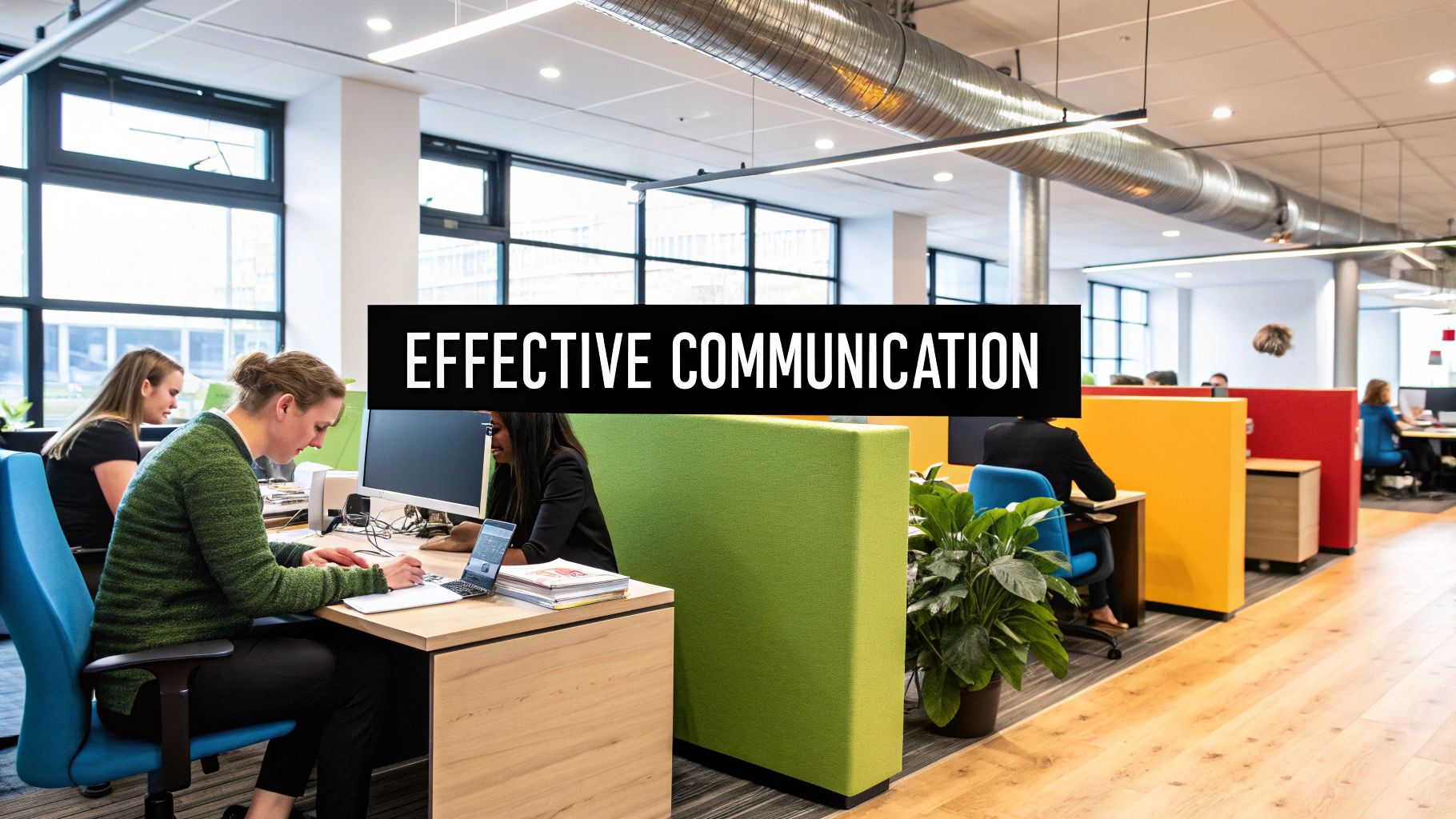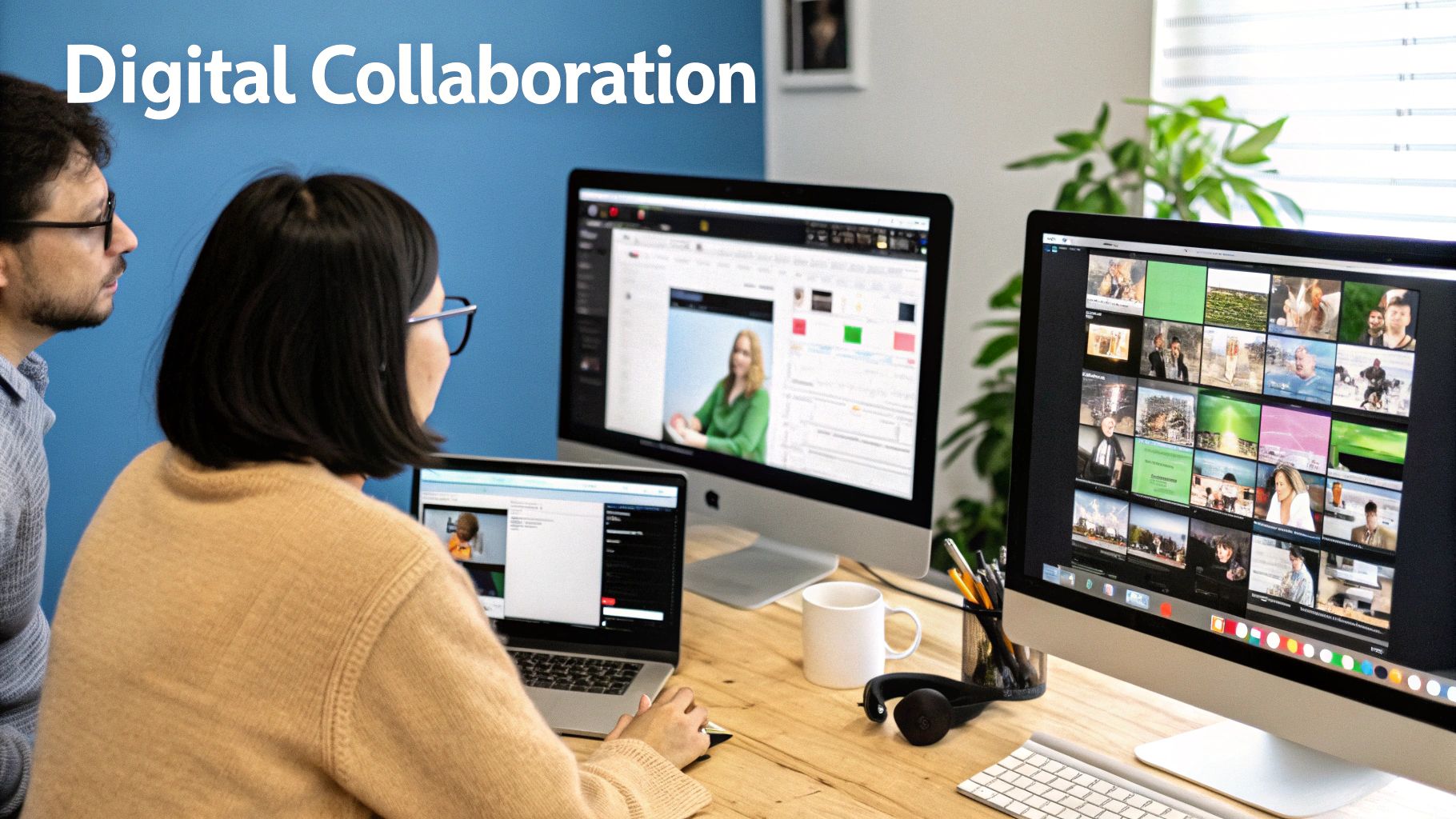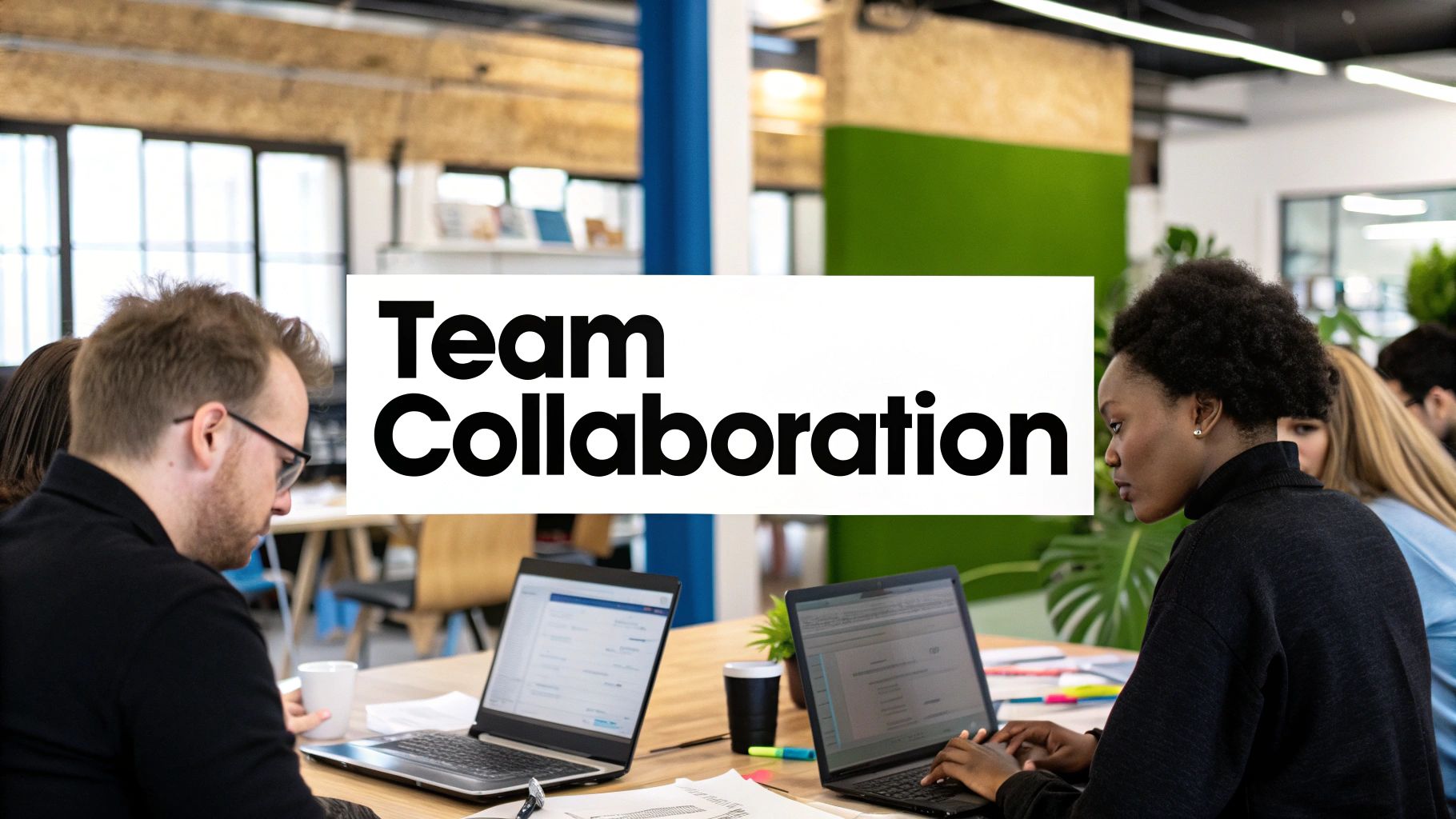Team Collaboration Best Practices: The Essential Guide to Building High-Performing Teams
The Strategic Impact of Team Collaboration

Good team collaboration isn't just about getting people to work together - it's about creating an environment where individual strengths combine to achieve common goals. When teams work well together, they communicate better, solve problems faster, and deliver stronger results. But what specific practices help organizations get the most value from collaboration?
Linking Collaboration to Measurable Results
The benefits of effective teamwork show up clearly in business results. When teams communicate well and coordinate their efforts, projects are more likely to finish on time and within budget. You can also see it in successful product launches and positive customer feedback that come from teams working closely together throughout development. These concrete outcomes demonstrate why investing in collaboration matters.
Research backs up the value of teamwork. A Stanford study found that people working collaboratively stay focused on tasks 64% longer than those working alone. They also report higher engagement, less fatigue, and produce better quality work. This boost in performance comes from the natural motivation of being part of a team and having others to bounce ideas off of. For more details on the research, check out these teamwork statistics from Runn.
Real-World Examples of Collaborative Success
Many companies have seen firsthand how good collaboration drives results. Take open-source software projects - developers across the globe work together to build high-quality programs through shared effort and clear communication. Similarly, businesses that encourage different departments to work together often develop and launch products more quickly by sharing knowledge and ownership. These examples show how making collaboration a priority gives organizations an edge.
Building a Foundation for Collaborative Growth
To gain lasting advantages, companies need to make collaboration central to their culture. This means putting in place collaboration best practices that help people work together effectively, communicate openly, and celebrate shared wins. Supporting this with the right training, tools like Pull Checklist for code review and project management, and recognition for team achievements creates an environment where collaboration thrives. When teams have what they need to work well together, they stay flexible and ready to tackle new challenges.
Breaking Through Collaboration Barriers

Getting teams to work together smoothly can be challenging, even when everyone understands the benefits. Common obstacles often get in the way and leave team members feeling frustrated. Understanding and addressing these roadblocks is key to helping teams reach their full potential.
Identifying Common Collaboration Challenges
Teams frequently face several key hurdles that can derail good collaboration practices. Communication gaps are one of the biggest issues - whether it's infrequent updates, unclear messages, or a lack of open discussion. Teams also struggle with role confusion, where people aren't sure what they're responsible for or how their work fits into the bigger picture. On top of this, workflow bottlenecks create delays when processes aren't clear or teams aren't coordinating well.
These collaboration problems significantly impact how much work gets done. Research shows that 64% of employees lose at least three hours weekly due to poor collaboration, with 20% wasting up to six hours. The main culprits? Too many meetings, repetitive feedback cycles, and unclear roles. For example, a Gartner study found that 84% of marketing teams face these frustrations, which hurt both job satisfaction and revenue goals. Learn more about the impact in these workplace collaboration statistics.
Overcoming Roadblocks With Practical Solutions
Teams can tackle these collaboration challenges with straightforward strategies. Using tools like Pull Checklist for code reviews and project tracking helps create clearer workflows and visibility. This allows teams to specify exactly what needs to be done in pull requests, making communication clearer and roles more defined.
Setting up clear communication channels makes a big difference too. Whether it's using project management tools, chat platforms, or regular team meetings, the goal is making sure everyone has the information they need when they need it. Clearly defining who does what from the start is also essential - it helps people understand their role and prevents duplicate work.
Building Trust in Remote and Hybrid Teams
Trust becomes especially important when team members work remotely or in hybrid setups. Regular virtual check-ins, team activities, and casual conversation opportunities help build stronger connections between teammates. This foundation of trust makes it easier for people to communicate openly, solve problems together, and work effectively as a team, particularly when they're not in the same physical space. Taking time to build these relationships pays off through better teamwork and results.
Mastering the Digital Collaboration Stack
Teams need a well-designed set of collaboration tools to work effectively together. The right mix of software isn't just about having lots of options - it's about carefully selecting and implementing tools that help your team communicate and work together smoothly.
Evaluating Tools Against Team Needs
With countless collaboration tools available, choosing the right ones can be daunting. Start by examining how your team actually works and identifying specific problems to solve. Are code reviews taking too long? Is poor communication leading to mistakes?
- List Your Pain Points: Write down exactly where better tools could improve how your team works together
- Focus on Must-Have Features: Pick tools that directly fix your biggest challenges. For example, if code reviews are slow, Pull Checklist can help with automated checks and simpler workflows.
- Check Tool Compatibility: Make sure new tools work well with your current systems to avoid disrupting your team's rhythm
This focused approach helps you pick tools that truly improve how your team works, without wasting money on unnecessary software.
Implementing New Solutions Smoothly
Adding new tools requires careful planning to avoid disrupting your team's work. Think of it like replacing parts on a car while driving - you need a clear plan to make the switch without causing problems.
- Start Small: Test new tools with one team or project first to work out any issues before rolling them out more widely
- Train Everyone Well: Give your team thorough training so they know how to use new tools effectively and feel confident with them
- Provide Help: Have people ready to answer questions and help solve problems as the team starts using new tools
Taking time to plan the rollout helps your team adapt to new tools smoothly and get the most benefit from them.
Optimizing Your Collaboration Stack for Peak Performance
Once your tools are in place, keep checking how well they're working and look for ways to improve. Key steps include:
- Monitor Usage: Track how much people use each tool and get their feedback about what's working well or causing problems
- Set Clear Rules: Create simple guidelines about when to use different tools to avoid confusion. For example, specify that all code reviews must use Pull Checklist
- Track Results: Measure things like project completion speed, code quality, and team satisfaction to see if the tools are helping. For instance, check if Pull Checklist has reduced bugs in your code
By actively managing your collaboration tools and adjusting based on what you learn, you can help your team work together more effectively over time. Remember that this is an ongoing process - keep refining your approach as your team's needs change.
Creating a Collaboration-First Culture

Real team collaboration goes deeper than just having the right tools. It requires building an environment where working together effectively becomes second nature. This means nurturing open dialogue, establishing common values, and making sure everyone feels secure sharing their thoughts.
Fostering Psychological Safety
Great collaboration happens when team members know it's safe to voice new ideas. When there's psychological safety, people aren't afraid to take calculated risks or ask for help when needed. Just like musicians in a jazz band playing off each other's energy, team members can bounce ideas around freely, leading to better solutions and more creativity.
Encouraging Open Communication and Shared Values
Clear, consistent communication sits at the heart of effective teamwork. Teams need transparent channels where information flows freely and everyone stays informed. They also need shared goals and values that unite them around a common purpose. Tools like Pull Checklist help by providing a central hub for pull request communication, making code review feedback and task requirements crystal clear.
Recognizing and Rewarding Collaboration
Celebrating team wins - both big and small - helps reinforce good collaborative habits. Something as simple as highlighting individual contributions in meetings or giving specific positive feedback can make a big impact. When you regularly recognize teamwork, you create momentum that inspires more collaboration.
Building Strong Cross-Functional Relationships
Effective collaboration often needs to span different departments. Building connections across teams through joint projects, regular cross-team meetings, or casual social events helps break down barriers. These interactions create understanding between groups and lead to smoother cooperation throughout the organization.
Developing Resilience Through Connection
Teams with strong bonds handle challenges better together. When there's a foundation of trust and respect, difficult situations become opportunities to grow stronger as a group. This kind of resilience comes from knowing you have supportive teammates who share your goals. Using platforms like Pull Checklist for code reviews helps build this resilience by making improvement and shared responsibility part of daily work, creating lasting team connections through regular positive interaction.
Using natural flow and style from the example:
Measuring Collaboration Excellence
Building a team that works well together requires ongoing evaluation and adjustment. Regular assessment helps teams identify what's working, spot challenges early, and make targeted improvements. The key is looking beyond basic metrics to understand the deeper aspects of how team members interact and support each other.
Choosing the Right Metrics
Smart teams track both numbers and experiences to get the full picture. While data points like completed projects and code quality give helpful productivity insights, they only tell part of the story. Team feedback through surveys and discussions reveals crucial information about morale, communication roadblocks, and group dynamics that numbers alone miss.
Take a project that finishes on schedule but leaves team members feeling disconnected or frustrated. Just looking at the timeline wouldn't show these underlying issues that can hurt the team over time. That's why successful groups use multiple ways to measure how well they work together.
Practical Approaches for Data Collection
Getting meaningful insights requires gathering information in several ways:
- Quick Check-Ins: Brief, regular surveys help spot potential problems before they grow
- Project Debriefs: After each project, discuss what went well and what could improve. Tools like Pull Checklist help by providing a central place to share feedback during code reviews.
- Activity Analysis: Review how the team uses communication tools like Slack and project management software to understand workflow patterns
Analyzing Collaboration Patterns and Implementing Improvements
Finding useful patterns in the collected information guides smart changes. For example, if surveys consistently show team stress during certain project phases, dig deeper to find out why. The team might need adjusted processes or extra support during those times.
Put improvements in place based on what the data reveals. This could mean adopting new tools, updating how the team communicates, or providing training. For instance, if code reviews keep catching the same issues, using Pull Checklist can help by providing clear guidelines right in pull requests. This improves code quality and helps the team work better together through shared expectations. Keep measuring results to make sure changes have the intended positive impact.
Building Tomorrow's Collaborative Teams

Successful teams need strong foundations to work effectively together. As work patterns shift and technology advances, organizations must focus on creating resilient teams that can adapt and thrive. Let's explore the key elements of building high-performing teams that excel at collaboration.
Adapting to Hybrid Work Models
The blend of remote and office work is now standard for many organizations. This shift demands thoughtful planning around communication and connection. Teams need both asynchronous tools (like shared docs and project boards) and real-time video meetings to stay aligned and build relationships. The key is finding the right balance - giving people flexibility while maintaining strong team bonds through regular face-to-face interaction.
Managing Cross-Cultural Teams
Global teams bring valuable diversity but also specific challenges. Different communication styles, work practices, and time zones require careful coordination. Clear protocols and cultural awareness training help team members understand each other better. Using translation tools and maintaining documentation in multiple languages ensures everyone can access and contribute to key information.
Leveraging Emerging Technologies
New tools are making collaboration easier and more effective. AI assistants handle routine work so teams can tackle strategic priorities. Virtual and augmented reality create shared digital spaces for remote teamwork. Tools like Pull Checklist improve technical collaboration by standardizing code reviews and facilitating clear feedback across time zones. Smart adoption of these technologies helps teams work better together.
Fostering Innovation in Distributed Teams
Keeping distributed teams connected and creative takes focused effort. Regular virtual social events and team activities help maintain personal connections. Online communities and discussion forums give people spaces to share ideas and solve problems together. By actively nurturing interaction and providing platforms for collaboration, organizations can help remote teams innovate effectively.
Building Sustainable Collaboration Practices
Strong collaboration needs clear frameworks that can grow with your organization. Well-defined processes for decisions, conflict resolution, and knowledge sharing provide consistency as teams expand. Regular training reinforces good practices and builds a culture of continuous improvement. This foundation helps teams collaborate smoothly regardless of size or complexity.
Ready to improve your team's code reviews and collaboration? See how Pull Checklist can help streamline your process.
